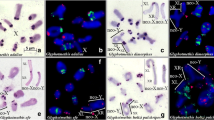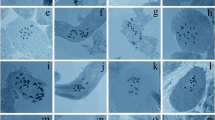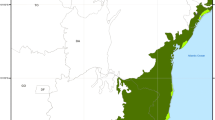Summary
A sample of 6 ‘Leggada’ from N'Délé (Central African Republic) morphologically different from all these studied up to now, constitue a new species, which will be described by Dr F.Petter asMus goundae Petter. The caryological analysis reveals a new robertsonian polymorphical system. The diploïd numbers are 2N=16, 17, 18 or 19, whereas theN.F. is constant and equal to 30. The 3 first pairs of autosomes, constituted by SM or MC elements are identical in the 4 types, as well as pairs V (MC) and VI (AC) morphologically constant by all individuals. The robertsonian mechanisms, from which polymorphism originates, take place at pairs IV, VII and VIII. The fourth pair, while heterozygote by 2N=19, assembling one MC and two AC elements, is homozygote and MC by 2N=18, 17 and 16; pairs VII and VIII are both constituted by two AC in the cases of 19 and 18 chromosomes; to form caryotypes with 17 and 16 chromosomes these 2 pairs will fusion: by 2N=17 the mutation is heterozygote (1 MC and 2 AC) and it becomes homozygote by 2N=16 giving birth to 2 MC. The sexual chromosomes are from TR Type (X MC andY SM).
From these observations arises the problem of low chromosome numbers (16–20) which shall be discussed in a further publication.
Similar content being viewed by others
Author information
Authors and Affiliations
Rights and permissions
About this article
Cite this article
Jotterand, M. Un nouveau système polymorphe robertsonien chez une nouvelle espèce de «Leggada» (Mus goundae Petter). Experientia 26, 1360–1361 (1970). https://doi.org/10.1007/BF02113032
Published:
Issue Date:
DOI: https://doi.org/10.1007/BF02113032




